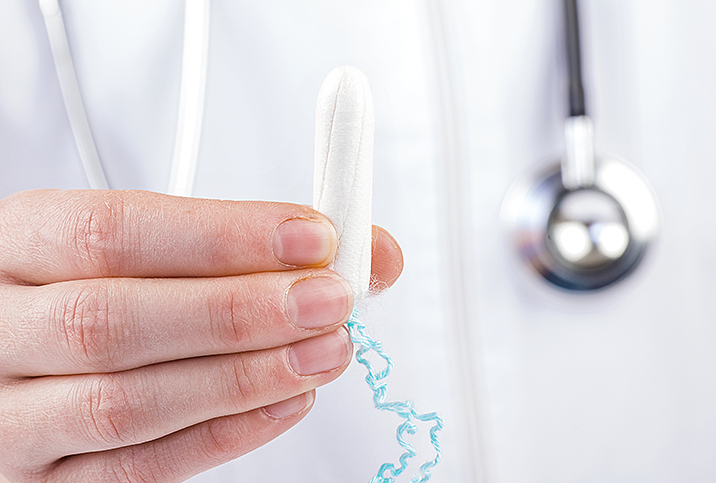A Date With My Dilator

Lying on my bed, bedsheets ruffled, legs up and pantless, I wait for the moment of insertion. I fumble with the smooth silicone device—this one is a dark purple, the last one was a light blue. The lights are dimmed, the flicker of the TV illuminates my hands and suddenly I gasp—it's in!
Vaginal dilator therapy is a type of treatment suggested by specialists to help train the pelvic floor muscles to accept objects the vagina would previously reject or clamp down on due to involuntary muscle spasms, a condition called vaginismus. An estimated 5 percent to 17 percent of women have this condition, according to a 2017 study published in Sexual Medicine.
"Vaginismus is not just a physical issue," said Sarah Berry, a U.K.-based psychosexual and relationship therapist. "It's a condition whereby the body is protecting you from invasion. People with vaginismus may also have unresolved trauma, relationship issues, anxiety, depression and maybe a general feeling that they aren't in control of their lives."
The spasms from the condition cause a searing pain while inserting objects like a tampon, a finger, a sex toy or a penis. The cause of the spasms can be psychological or physical—some patients have a history of sexual assault, while others have no reason for their body's automatic response.
By inserting a dilator, your vaginal muscles become more accustomed to an object entering the vaginal canal, which can help reduce pain during sex. Dilating, however, isn't anything like masturbating—it's typically not a pleasurable experience. In fact, dilating is an exercise. And as with working out, if you don't stretch before you hit the gym, you can experience muscle spasms and tightness.
"Rather than altering the anatomy of the vagina, it helps to train the Kegel muscle into relaxing and the user to get used to accepting increasingly different-sized entities into their vaginas," Berry said.
Okay, you have your dilators. Now what?
Dilators can be purchased from a sex shop or through the recommendation of a doctor, who may have them available for patients. They come in a variety of materials, including plastic, glass and silicone, and in graduated sizes that range from tampon-sized to that of a girthy cucumber.
Once you've got the right fit for your needs, while in a comfortable position, slowly insert the dilator, tilting it slightly upward. If you feel pain or resistance, breathe slowly to allow the muscles to relax. Deeply and slowly inhale and exhale the entire time to practice the release of the muscles and to remain calm. The dilator may not fit inside entirely, and every day may be different, so expect some setbacks. Once you feel comfortable with the dilator inserted, use your hand to keep it in place.
By inserting a dilator, your vaginal muscles become more accustomed to an object entering the vaginal canal, which can help reduce pain during sex.
Remember: Moving up sizes with dilators takes time. When I finally graduated to a bigger size, drowning it with lube and lying completely still after insertion, I was totally immobilized and fearful. The pelvic muscles might push the dilator out, shooting it onto the bed (which is why lying with a towel beneath you can be beneficial), so holding it with your hand for approximately 10 to 15 minutes will keep it in place. Another factor to consider is that moving on to a larger size may be too difficult, and you may even need to go backward in size. The key is to not get discouraged and to stick with the process.
When the device is inserted, try to sit up or roll over in the bed and move the dilator in and out to simulate sexual intercourse or masturbation. Once this feels comfortable and pain-free, it's OK to move up in size. If you find yourself stuck at a certain size for weeks or months, don't panic. This is a form of therapy, not a quick-and-easy fix.
Make it a self-care date
In order to make this experience less dreadful, make sure your attention isn't solely focused on the dilator. Binge Netflix, listen to music, practice breathwork or scroll through social media. I would turn on "Sex and the City," dim the lights and surround myself with pillows. Working toward curing your vaginismus is a form of self-care, so treat it that way.
"I've been using dilators for a year," said Rebecca, 25, a Chicago-based bookstore clerk. "I have a long history with sexual assault and I've always struggled with having successful penetrative sex." As a queer person, Rebecca has experimented with strap-ons and sex toys with partners, but penetration has always been incredibly painful. "I've seen a huge improvement since starting dilators, but it's a super-slow process," she continued.
Rebecca's dilator routine involves her partner, too. After work, she usually jumps into bed with her girlfriend, who strokes her hair or turns on ambient music as she inserts her plastic devices. "We don't kiss or try to associate dilating with too much sexual energy, but she does caress or massage me to ease any tension or stress about the situation," Rebecca explained. For 10 minutes, Rebecca will recline next to her partner while using pillows as a way to support her knees and create a diamond shape with her legs.
'Remember, it's a marathon, not a sprint.'
"I'm only on the third dilator size right now and can't seem to move past it, but it's such an exciting thing to see progress," said Rebecca, who has never been able to insert a tampon. She was diagnosed with vaginismus two years ago after trying for seven years to find a reason for her pain during sex. "Dilating is a bitch. It's hard, exhausting and sometimes just really boring," she said. "But I see improvements and I'm pumped to finally be able to be intimate with my partner on a level where we don't have to worry about me wincing in pain."
It's a long but worthwhile process
The first successful insertion may take a long time. "Listen to your body and be kind to yourself. Slow and steady is much more important," Berry said. "It's very important that people work out their own path through this. If they are inserting things in their vagina but not feeling good about it, then this can make it worse. Avoidance is a constant bedfellow with vaginismus. If you've bought your insertables and aren't using them, then think about what's blocking you."
Jumping into dilation therapy can be daunting—and if you're someone who is recovering from sexual assault, the process can be triggering, too. "It can be helpful to take note of how you feel before, during and after dilation," Berry advised. "If there is pain, rate this 1 to 2 and try to describe the pain. Is it sharp? Burning? If it's uncomfortable, then that's different from pain, so rate that 1 to 5. Also with tightness. You may find that it's OK to get, say, the tip in and then it feels tighter the more you enter."
Berry also noted that writing down your mood and levels of nervousness and tenseness can help you monitor what influences your vagina. "Remember, it's a marathon, not a sprint," she added.
This is why it's crucial to create a warm, safe and comfortable space each time you introduce a dilator. For a solid year, I carved out a chunk of time each evening and jumped into bed with my silicone devices. The nervousness would eventually melt away, and insertion became easier and more comfortable as time progressed. Dilators won't deliver a quick fix—it takes time and a hell of a lot of patience—but, ultimately, they helped me attain pleasurable pain-free sex.





















Commentary